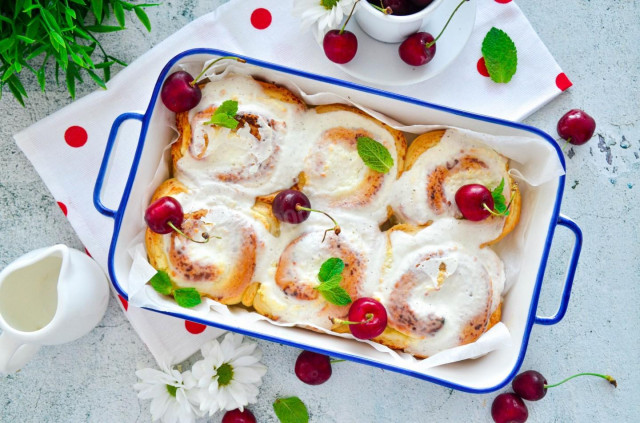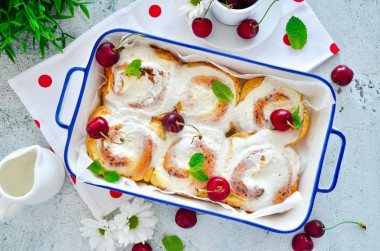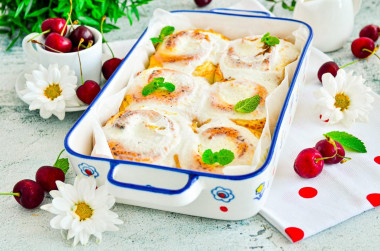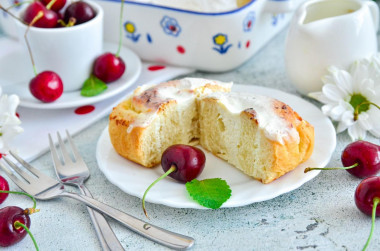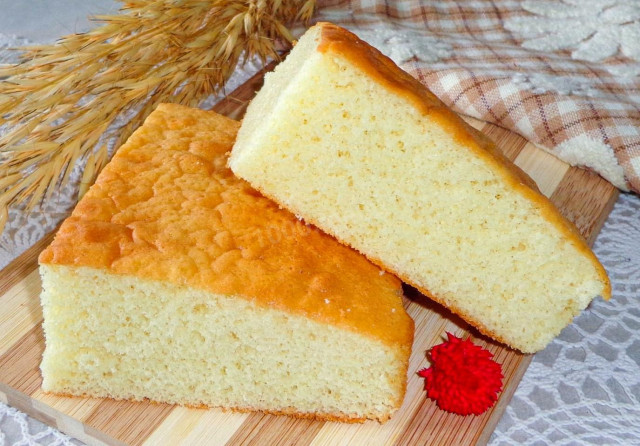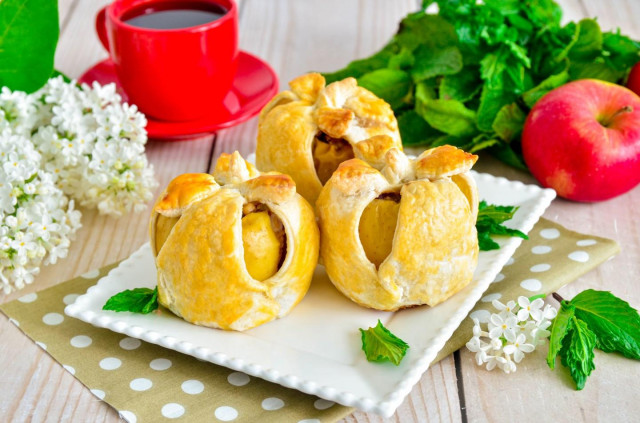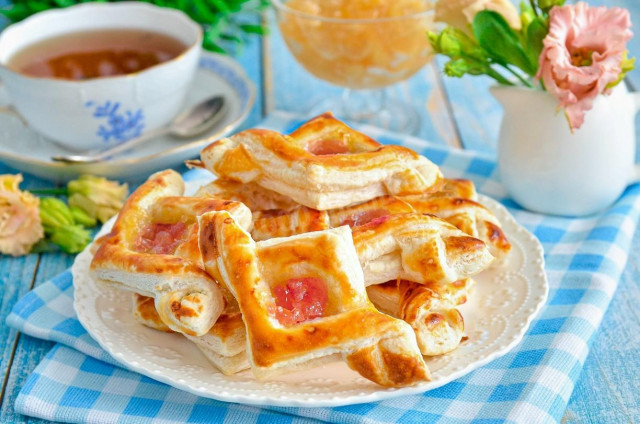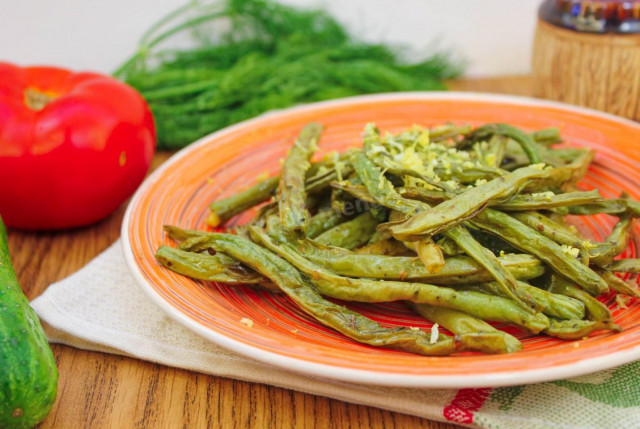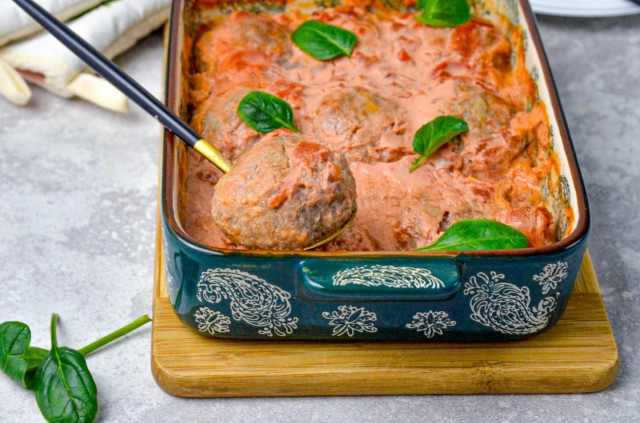Composition / ingredients
Step-by-step cooking
Step 1:
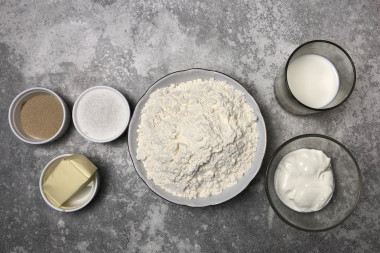
How to make curd curls in sour cream filling? Start cooking by kneading the dough. Prepare the products. Take high-quality, natural butter and sour cream, without milk fat substitutes. Sour cream is better suited with a fat content of 20-30%, milk — 3.2%. You can use fresh yeast instead of dry yeast. They will then need 8 grams.
Step 2:
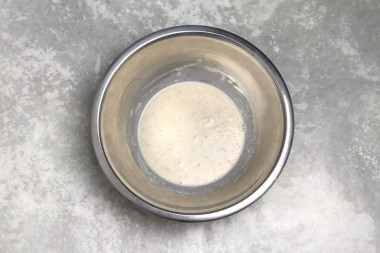
How to make dough? This recipe is prepared with a sourdough. How to make sourdough? Heat the milk to a temperature of 38-40 degrees, but in no case more. In a hot environment, yeast can die, the most comfortable temperature for their activation is a pleasantly warm liquid. Pour the milk into a bowl, add a teaspoon of sugar from the total amount, leave the rest of the sugar for now. Stir in the sugar and milk. Sift three tablespoons of flour from the total amount into the dough.
Step 3:
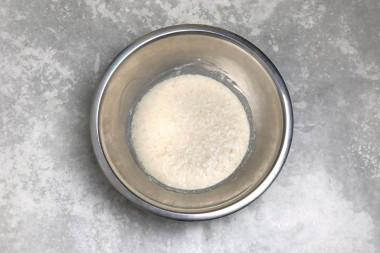
Add yeast. Mix the dough well until smooth. Cover the bowl with a towel and leave for 15-20 minutes to activate. You can put it away in a warm place, I left it on the table because it's warm at home. After 20 minutes, the sourdough will bubble up strongly — this means that the yeast is active and has started its work. If this did not happen, you will have to take others.
Step 4:
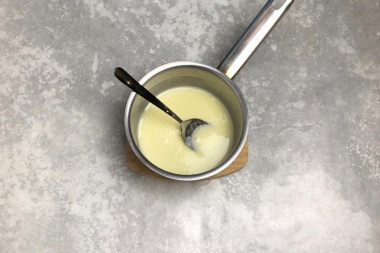
While the sourdough is rising, take care of the other ingredients for the dough. Melt the butter in any way convenient for you. I made it in a saucepan with a thick bottom on the stove. Cool the melted butter a little and pour sugar and salt into it. Mix it up. Add sour cream and stir until smooth.
Step 5:
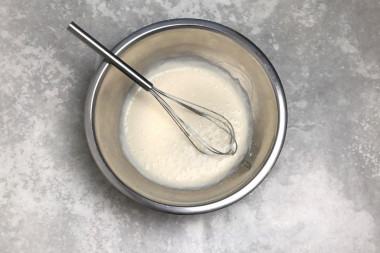
Mix the approaching sourdough and pour the oil mixture into it. Stir everything again.
Step 6:
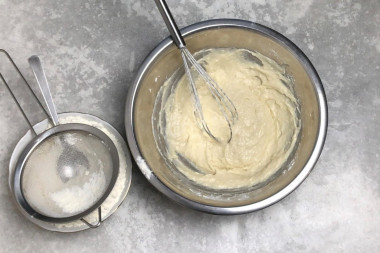
Sift about a third of all the flour into the dough, stir with a whisk. Then the next third, stir again. Add the remaining flour already by a tablespoon, put the whisk aside and knead the dough with your hands. This is done in order to feel the consistency of the dough and not "score" it with flour. Do not forget to sift the flour before adding — this will make the baking more airy.
Step 7:
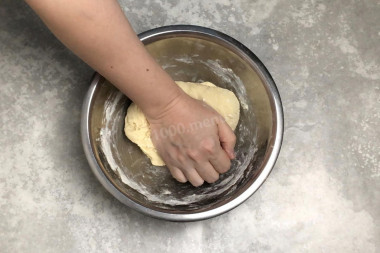
An overabundance of flour will make the dough stiff and not tasty. As a result, not all the flour left me, 50 grams remained. The dough stopped sticking pretty quickly and began to lag behind the walls of the bowl.
Step 8:
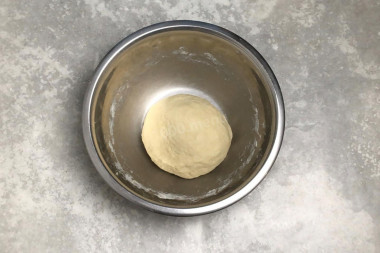
Knead the dough until smooth, homogeneous, about 5 minutes. I kneaded right in the bowl, you can do it on a table or a board. Assemble the finished dough into a ball, put it in a bowl, cover it with a towel or a film. Remove the bowl to a warm place to rise for 1 hour. I always put the dough in a cold oven.
Step 9:
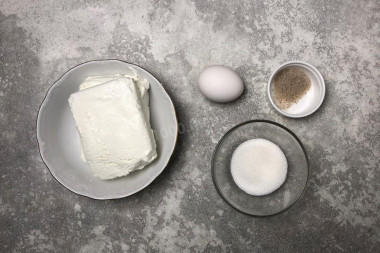
While the dough is rising, prepare the filling. How to make the filling? Take cottage cheese, it will taste better with the fattest — 9-18%. Choose natural cottage cheese, without additives, not grained. Flavor (vanilla) put to taste. I have vanilla sugar with natural vanilla, you can use vanilla (on the tip of a knife) or vanilla in pods (seeds of half a pod).
Step 10:
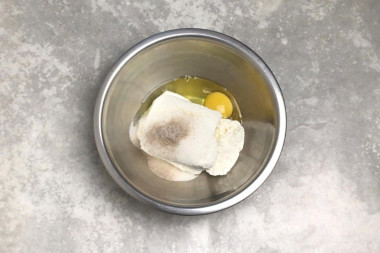
Put the cottage cheese in a bowl. Beat an egg into a bowl, add sugar, plain and vanilla.
Step 11:
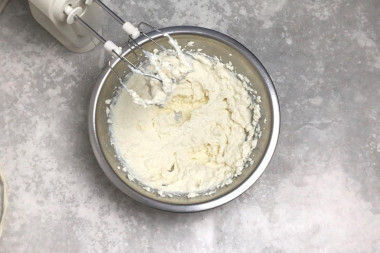
Beat the filling with a mixer. Or an immersion blender, depending on the cottage cheese. I have it soft, a mixer was enough, it's better to punch a coarse one with a blender. The filling is ready, cover the bowl and set it aside for a while.
Step 12:
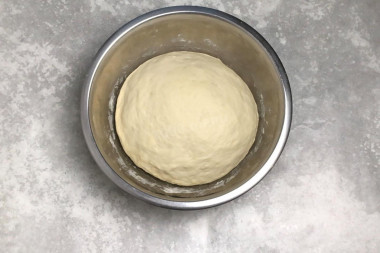
After an hour, the dough should double in volume. Lightly knead it and put it on the work surface. It is not necessary to sprinkle it with flour, the dough is absolutely not sticky.
Step 13:
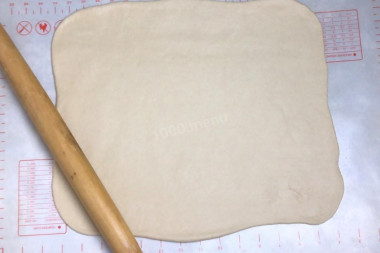
Roll out the dough into a layer ~ 30*35 cm in size. 5-7 mm thick.
Step 14:
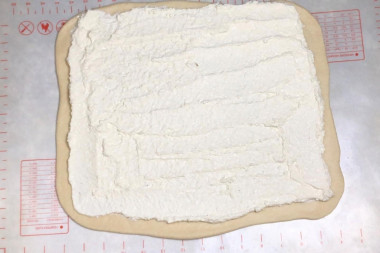
Grease it with cottage cheese filling, not reaching 1 cm from two short sides and one long.
Step 15:
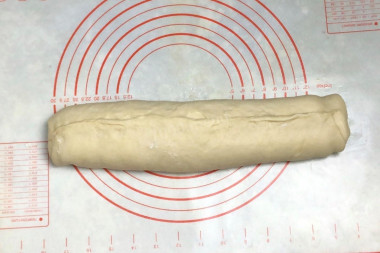
Roll the dough into a tight roll, twist it from the long side that is completely smeared. Pinch the seam of the roll well. Mash the roll with your hands, evenly distributing the filling and shaping it.
Step 16:
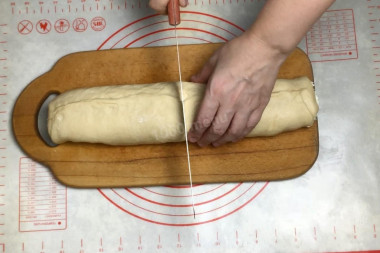
Cut the roll into 12 pieces. It will be most convenient to do this with a bread knife with notches — it will cut, not crumple the dough.
Step 17:
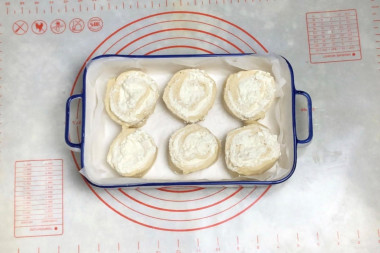
Take a suitable baking dish. It can be a large baking tray or several baking pans. I got two shapes, one measuring 31*17 cm, the other 20*20. I'm only shooting one. Cover the forms with parchment, it will be better so that the curd filling does not burn. To make the paper fit into the mold, fold it with your hands. Put the curls in the form. Those buns that were from the edges of the roll, put the slice up.
Step 18:
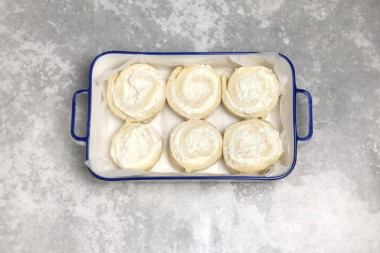
Cover the molds with blanks with a towel and leave to rest for 30 minutes. During this time, they will grow up a little.
Step 19:
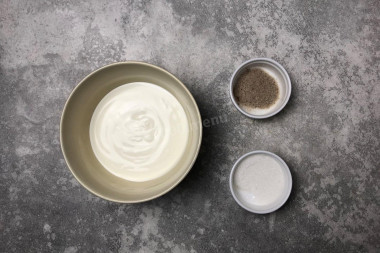
While the buns are resting, prepare the sour cream filling. Take sour cream thick and greasy. Add vanilla to taste. Like sugar. I'll put in more next time.
Step 20:
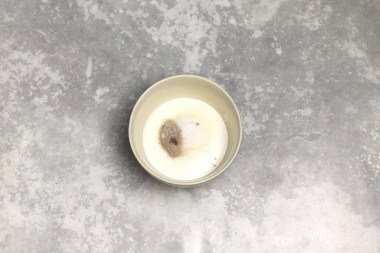
How to make a fill? Add sugar, plain and vanilla to the sour cream.
Step 21:
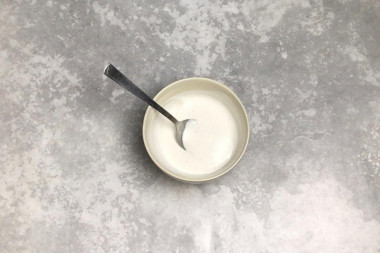
Mix with a spoon until smooth. Leave the curls for the baking time, the sugar will just dissolve in the sour cream.
Step 22:
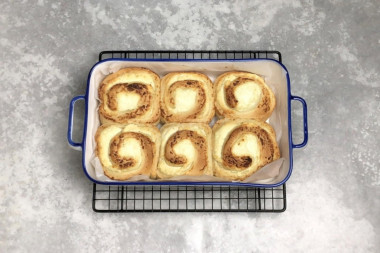
Preheat the oven to 170 ° C, I have an electric, top-bottom mode. Bake the buns for 45 minutes, until golden.
Step 23:
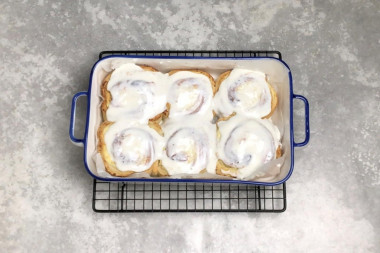
Remove the finished curls from the oven and immediately smear with sour cream filling.
Step 24:
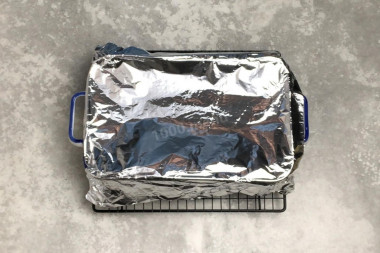
Cover the mold with foil and leave them to cool. You can completely, or you can serve them warm — buns are good in any form.
Step 25:
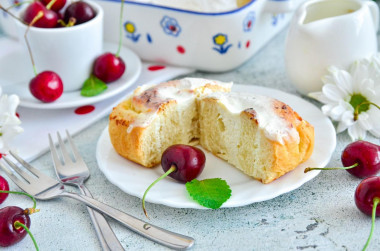
The curls turn out incredibly soft and fluffy, they taste like cheesecakes, only much juicier due to sour cream filling. Bon appetit!
Be sure to wash the eggs before use, as even the seemingly clean shell may contain harmful bacteria. It is best to use food detergents and a brush.
Butter can be melted in the microwave or in a water bath.
How to melt butter in the microwave?
Cut the butter into small pieces and place it in a special container. To prevent the oil from splashing when heated, cover the oil vessel with a paper towel. The oil should be melted either at the lowest power or in defrosting mode. At first, five seconds will be enough. Next, if the butter has not melted yet, set it again for 5 seconds and start the microwave. Repeat the process several times until the desired result.
How to melt butter in a water bath?
You will need two containers of different diameters. Pour water into a large one and put it on the stove. Place the smaller container on top so that it is submerged in water by about half. Put the sliced butter into it. Under the influence of boiling water, the oil will begin to melt. Stir the oil slightly to speed up the process. As soon as the pieces of oil are completely dissolved, remove the container from the stove.
Keep in mind that everyone's ovens are different. The temperature and cooking time may differ from those specified in the recipe. To make any baked dish successful, use useful information about the features of ovens !
Caloric content of the products possible in the composition of the dish
- Whole cow's milk - 68 kcal/100g
- Milk 3.5% fat content - 64 kcal/100g
- Milk 3.2% fat content - 60 kcal/100g
- Milk 1.5% fat content - 47 kcal/100g
- Concentrated milk 7.5% fat content - 140 kcal/100g
- Milk 2.5% fat content - 54 kcal/100g
- Sour cream with 30% fat content - 340 kcal/100g
- Sour cream of 25% fat content - 284 kcal/100g
- Sour cream with 20 % fat content - 210 kcal/100g
- Sour cream of 10% fat content - 115 kcal/100g
- Sour cream - 210 kcal/100g
- Chicken egg - 157 kcal/100g
- Egg white - 45 kcal/100g
- Egg powder - 542 kcal/100g
- Egg yolk - 352 kcal/100g
- Ostrich egg - 118 kcal/100g
- Cottage cheese of 40% fat content - 466 kcal/100g
- Cottage cheese of 20% fat content - 233 kcal/100g
- Cottage cheese of 18% fat content - 226 kcal/100g
- Cottage cheese of 10% fat content - 156 kcal/100g
- Low-fat cottage cheese - 75 kcal/100g
- Cottage cheese with sour cream - 260 kcal/100g
- Fruit cottage cheese - 147 kcal/100g
- Soft dietary cottage cheese - 170 kcal/100g
- Vitalinia cottage cheese - 64 kcal/100g
- Cottage cheese "morning" ( "danone") without sugar - 91 kcal/100g
- Cottage cheese - 156 kcal/100g
- Granulated sugar - 398 kcal/100g
- Sugar - 398 kcal/100g
- Butter 82% - 734 kcal/100g
- Amateur unsalted butter - 709 kcal/100g
- Unsalted peasant butter - 661 kcal/100g
- Peasant salted butter - 652 kcal/100g
- Melted butter - 869 kcal/100g
- Salt - 0 kcal/100g
- Wheat flour - 325 kcal/100g
- Vanilla sugar - 379 kcal/100g
- Dry yeast - 410 kcal/100g

